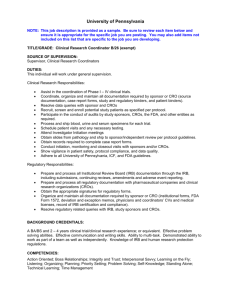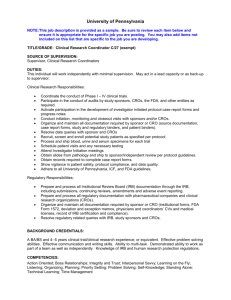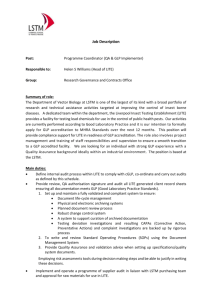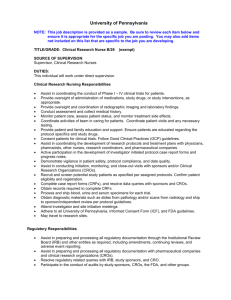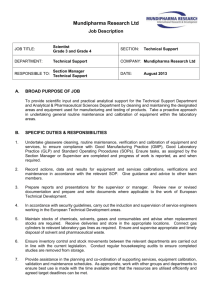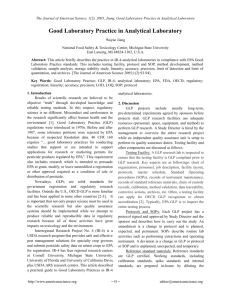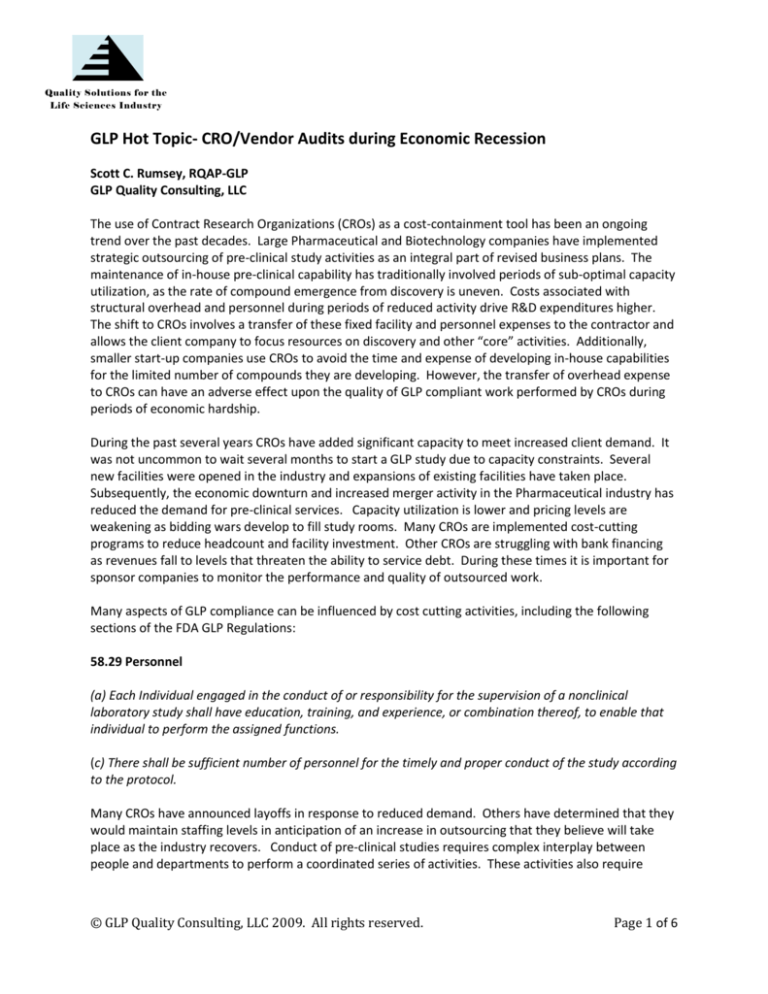
Quality Solutions for the
Life Sciences Industry
GLP Hot Topic- CRO/Vendor Audits during Economic Recession
Quality Solutions for the
Life Sciences Industry
Scott C. Rumsey, RQAP-GLP
GLP Quality Consulting, LLC
The use of Contract Research Organizations (CROs) as a cost-containment tool has been an ongoing
trend over the past decades. Large Pharmaceutical and Biotechnology companies have implemented
strategic outsourcing of pre-clinical study activities as an integral part of revised business plans. The
maintenance of in-house pre-clinical capability has traditionally involved periods of sub-optimal capacity
utilization, as the rate of compound emergence from discovery is uneven. Costs associated with
structural overhead and personnel during periods of reduced activity drive R&D expenditures higher.
The shift to CROs involves a transfer of these fixed facility and personnel expenses to the contractor and
allows the client company to focus resources on discovery and other “core” activities. Additionally,
smaller start-up companies use CROs to avoid the time and expense of developing in-house capabilities
for the limited number of compounds they are developing. However, the transfer of overhead expense
to CROs can have an adverse effect upon the quality of GLP compliant work performed by CROs during
periods of economic hardship.
During the past several years CROs have added significant capacity to meet increased client demand. It
was not uncommon to wait several months to start a GLP study due to capacity constraints. Several
new facilities were opened in the industry and expansions of existing facilities have taken place.
Subsequently, the economic downturn and increased merger activity in the Pharmaceutical industry has
reduced the demand for pre-clinical services. Capacity utilization is lower and pricing levels are
weakening as bidding wars develop to fill study rooms. Many CROs are implemented cost-cutting
programs to reduce headcount and facility investment. Other CROs are struggling with bank financing
as revenues fall to levels that threaten the ability to service debt. During these times it is important for
sponsor companies to monitor the performance and quality of outsourced work.
Many aspects of GLP compliance can be influenced by cost cutting activities, including the following
sections of the FDA GLP Regulations:
58.29 Personnel
(a) Each Individual engaged in the conduct of or responsibility for the supervision of a nonclinical
laboratory study shall have education, training, and experience, or combination thereof, to enable that
individual to perform the assigned functions.
(c) There shall be sufficient number of personnel for the timely and proper conduct of the study according
to the protocol.
Many CROs have announced layoffs in response to reduced demand. Others have determined that they
would maintain staffing levels in anticipation of an increase in outsourcing that they believe will take
place as the industry recovers. Conduct of pre-clinical studies requires complex interplay between
people and departments to perform a coordinated series of activities. These activities also require
© GLP Quality Consulting, LLC 2009. All rights reserved.
Page 1 of 6
Quality Solutions for the
Life Sciences Industry
extensive education and training in standard operating procedures, scientific judgment, regulation and
attention
detail. A CRO which has recently engaged in a workforce reduction is in danger of upsetting
Quality Solutions
forto
the
Life Sciences
Industry
the balance required for effective study conduct. Assessments of the number of personnel and their
expertise are particularly important during periods of workforce reduction. Some questions to answer:
1.
Has there been a workforce reduction? If so, how many people and in which departments?
2. What criteria were used to determine which staff members were affected by work force
reduction?
3.
Does management have a plan for staffing increases at the time of increased demand? How
will personnel be trained?
4. Are there sufficient numbers of personnel at the facility to conduct the work? Are any
personnel required to work overtime to complete the workload?
5.
Who will be performing work on your studies and what are their educational background,
training and experience?
Clues to assist with determination of personnel staffing issues can be found by observing the capacity of
animal rooms during facility tours, reviewing study data to determine missed/late time points, increased
data errors or delays in the timing of notifications and/or corrective actions. Has the facility maintained
appropriate personnel training programs, support for attendance at professional meetings/seminars or
have they been delayed or cut?
58.31 Testing Facility Management
Under GLP, the management has several functions including appointing and replacing study directors,
assuring that a quality assurance unit is in place, assuring personnel, resources, facilities and equipment
are available and that personnel are adequately trained. It is important to determine the attitude of
facility management toward these tasks. Is the management sufficiently concerned with maintaining
high levels of quality, even at the expense of temporary reductions in profit? Or are they overly
influenced by short-term thinking to meet Wall Street earnings per share each quarter? Do they view
clients as partners or as discrete transactions? What level of management involvement is displayed in
client interactions and visits? Do they express interest in client feedback and make prompt corrections,
as needed? These are sometimes difficult items to determine, but perhaps this statement by a CEO
during a recent earnings conference call will illustrate the proper attitude:
Analyst question: “But I guess shifting gears, several quarters ago, you were asked on a public call
what you would do if Tox and Early Development didn't show improvement over the longer term, and
there was some suggestion that you might be a little more aggressive with cost-cutting and taking
actions to help protect the bottom line.
We're now effectively a year into the slowdown in early stage for the industry and the margin did hit a
new low this quarter. So I'm curious whether the company's attitude has changed at all regarding
© GLP Quality Consulting, LLC 2009. All rights reserved.
Page 2 of 6
Quality Solutions for the
Life Sciences Industry
maintaining staff levels and infrastructure or whether we might see you get a little more aggressive with
proactive
Quality Solutions
forcost
the controls over the next few months and just kind of how you're thinking about that
Life Sciences
Industry
philosophically.”
CEO Response: “I guess the last thing, and you know very well, is that our commitment to talent and the
time that we spend training and developing the specialized talent we need is core to this company, and
we're not like a manufacturing facility where we can lay off a bunch of hourly workers and they go on
unemployment for a while and they are happy when we call them back. You know, these are people that
take six months to a year to recruit and three to six months to even get qualified to touch a study and a
year before they are good and three years before they create value for clients. I know that sounds like
mom and apple pie, but that's how we're running the company. So we're thinking of ourselves as a drug
development company. We continue to try to build the strength across the portfolio. There are times
when one of the kids seems to always be sick, but the breadth and the depth of the portfolio has what
kept us on track and we're very disappointed, clearly, with Early Development. Some things really
surprised us, you know, over the last couple of months, but we're not in debt. We're not crashing into
debt covenants and we're managing for the longer term.
So the short answer, is I don't see any big decisions coming out right now and I just hope that investors
and clients are happy six months from now when we are helping lead what we think will be a step wise
change in outsourcing.”
Management’s long-term thinking, a commitment to quality and the well-being of staff will filter down
through the company and will usually result in a superior product offering from a CRO.
58.33 Study Director
As the single point of study control and oversight, the study director is a crucial aspect of GLP study
conduct. It is important that they are able to adequately devote time to each study for which they are
responsible. Some questions to ask:
1.
How many studies have been assigned to each study director? Do they have enough time to
adequately oversee the workload?
2. How much experience does the study director have with the study types being overseen?
3. Does the study director have the appropriate education and experience to perform their role?
4. How much time does the study director require to respond to quality assurance audits, issue
protocol amendments, or respond to sponsor inquiries?
5. Has the study director personally visited the study rooms? If so, how often? Are there meetings
between the study director and other staff to discuss study conduct? If so, how often?
© GLP Quality Consulting, LLC 2009. All rights reserved.
Page 3 of 6
Quality Solutions for the
Life Sciences Industry
Quality Solutions for the
Life Sciences
58.35Industry
Quality
Assurance Unit
The quality assurance unit is an important part of assuring GLP compliance at a CRO. In the absence of a
sponsor presence at a test facility, they are the day-to-day “eyes and ears” to identify gaps or
weaknesses in regulatory compliance. It is important to maintain sufficient staffing levels to allow for
appropriate audits and inspections of studies and facilities. The following areas should be examined:
1.
How many QAU staff are present at the CRO? Have the numbers recently changed? How many
QAU staff are present in relation to the number of studies supported? In relation to technical
staff numbers?
2.
Examine the number of inspections required for each study and determine that adequate
numbers of inspections are conducted.
3. Examine the facility audit schedule and determine if the inspections are being conducted in a
timely manner. Are there any delays in completing the schedule?
4. Examine the QAU audit reports for types of findings/ frequency of findings that may indicate
sub-par quality in study conduct. Have the findings been addressed in a timely fashion?
5. Determine the data and report auditing procedure. Is there sufficient sampling/review of data
points? How much time does a data or report audit take to complete?
6. An examination of the master schedule may allow for determination of workload. Often these
records can be sorted by number of studies per study director and number of studies in-process,
in the reporting stage, etc. This can be useful as an index of overall facility staffing levels.
Subpart C Facilities
A tour of the contractor facility can be an important indicator of the state of GLP compliance. Costcutting activities may become evident during a walk-though of the buildings. Adequate investment in
structure and maintenance activities should be assessed:
1. Are the buildings and grounds maintained in good condition? Are any sections of the buildings
shut down for lack of use?
2.
Are hallways and study rooms clean? Is animal bedding of good quality and changed at
appropriate intervals? Are cages being cleaned at appropriate intervals?
3. Are feed and bedding areas stocked? Is the feed used within any expiration date(s)?
4. Does the facility have a pest control program? Have there been recent problems with pests?
© GLP Quality Consulting, LLC 2009. All rights reserved.
Page 4 of 6
Quality Solutions for the
Life Sciences Industry
Subpartfor
D Equipment
Quality Solutions
the
Life Sciences Industry
The use of properly maintained equipment is crucial to the generation of accurate and reliable GLP
study data. A review of the equipment status and calibration/maintenance activities can be an indicator
of whether management is spending adequate resources on study conduct:
1. Is the equipment used on studies in proper condition? Is the equipment old/outdated
technology? Is there an adequate amount of equipment to cover the workload in the facility?
2. Are appropriate SOPs in place and being followed for periodic maintenance and calibration
activities? Have these SOPs recently been changed to reduce frequency of
maintenance/calibration activities?
3. Examine equipment logbooks to determine frequency of maintenance activities. Are SOPs being
followed for timing and conduct of maintenance/calibrations? Is there an increase in the
number of times equipment is out of service or broken down?
58.81 Standard Operating Procedures
Standard Operating Procedures should be reviewed to determine that SOPs exist for all appropriate
activities and that they are being revised to reflect current practice. In addition, recently revised SOPs
should be reviewed to determine if there is a trend in reduction of maintenance/calibration activities,
coverage of quality assurance audits, or other indications of cost-cutting that may affect the quality of
work performed. There is a thin line between increased efficiency and cost cuts that may impact the
quality of work. Changes should therefore be assessed to determine if they are simply a “work smarter”
change, or if they seem to be a cost cutting exercise that may affect study conduct.
58.83 Reagents and Solutions
During tours of the facility, reagents and solutions should be examined to determine that expired
materials are not used. Materials should not be used beyond the manufacturer’s suggested expiration
date. Also, SOPs on reagent labeling and the determination of assigned expiration dates should be
reviewed to determine appropriate use.
58.185 Reporting of nonclinical laboratory study results
Many study sponsors spend resources to initially visit and evaluate CROs physical facilities and
procedures, but fail to properly evaluate the accuracy of reported study results. Reliance is placed upon
the CRO internal QAU function to ensure reports accurately reflect the study data. However, the
evaluation of the effectiveness of the CRO QAU cannot be properly performed unless a review of
selected draft audited reports to the data is conducted. Often it is discovered that significant errors or
omissions were missed by the internal QAU through scientific review by the sponsor monitor or
© GLP Quality Consulting, LLC 2009. All rights reserved.
Page 5 of 6
Quality Solutions for the
Life Sciences Industry
scientists. However, many errors cannot be discovered without an on-site comparison of the CRO data
to the report.
Quality Solutions
for the This review of CRO audited reports also has the advantage of allowing for a review of the
Life Sciences
Industry
data recording and documentation practices on the study. Proper documentation practices are crucial
to study reconstruction and provide assurance that data are being collected in conformance with GLP.
Therefore, a periodic independent second review of CRO reports to study data is needed to maintain
confidence in the CRO QAU function.
Other (Financial) Factors
While outside the immediate scope of the GLP regulations, it is important to review the financial
standing of contractors used for GLP studies. During previous downturns in the industry, several CROs
became insolvent and exited the business. Sponsor companies were forced to try to salvage longerterm studies that were conducted at these facilities and were obligated to provide additional funding,
repeat studies or attempt to relocate studies. At the current time (November of 2009) the author is
aware of one major CRO which has been forced to revise its banking agreements due to the decline in
revenue due to the economic downturn. Business development groups should regularly check the
credit status of CROs prior to use and periodically thereafter. Information on publicly traded companies
can be found at rating agencies such as Standard & Poors and Moodys. Transcripts from earnings
conference calls are available on-line at sites such as Seeking Alpha
http://seekingalpha.com/tag/transcripts and other sources. These transcripts are useful to determine
CRO management plans for facility closure, layoffs, financial updates and backlog.
Conclusion
The use of CROs for the conduct of pre-clinical studies is a trend that will continue in the future. CROs
offer unique expertise and the ability of the Sponsor to more easily adjust pre-clinical spend based upon
workload. However, with this transfer of financial risk comes the risk that CROs may implement costcuts that impact the quality of work performed. These risks require monitoring, especially during
periods of financial stress, to ensure work is conducted according to expectations, applicable
regulations, and timelines. The Sponsor is ultimately responsible for the data submitted to the
regulatory agencies, and therefore selecting and monitoring the appropriate CRO partners is a critical
activity.
© GLP Quality Consulting, LLC 2009. All rights reserved.
Page 6 of 6

